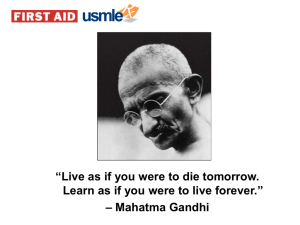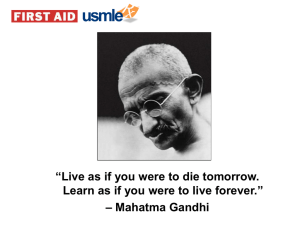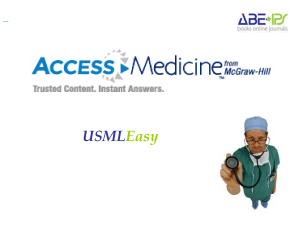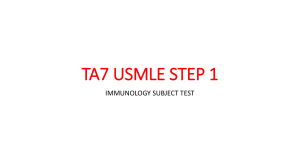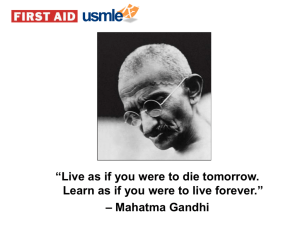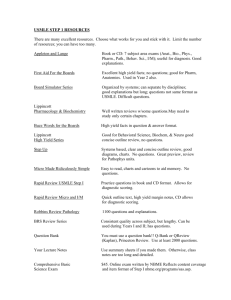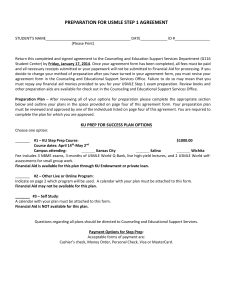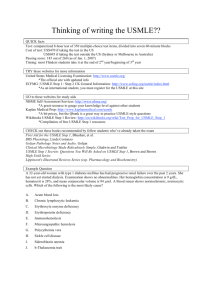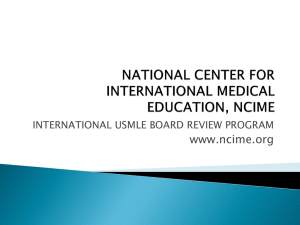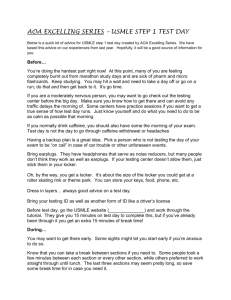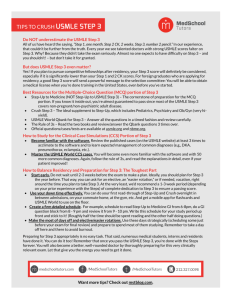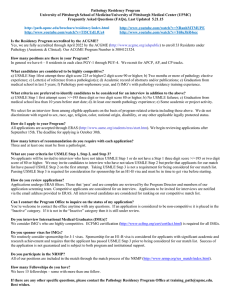First Aid for the USMLE Step 1
advertisement
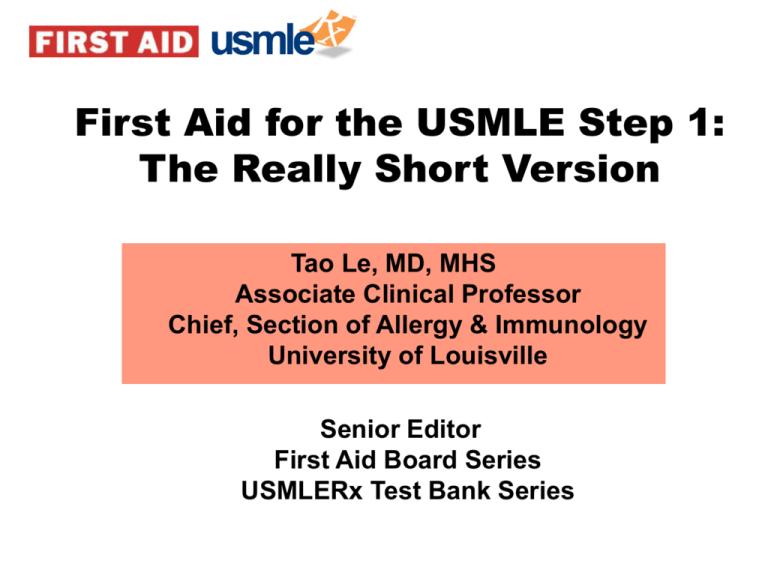
First Aid for the USMLE Step 1: The Really Short Version Tao Le, MD, MHS Associate Clinical Professor Chief, Section of Allergy & Immunology University of Louisville Senior Editor First Aid Board Series USMLERx Test Bank Series Relax. Overview USMLE Step 1 – The Basics Defining Your Goals Timelines for Study Approaching Each Subject Choosing Prep Resources More Tips Updates on First Aid/USMLERx Q&A USMLE Step 1 - The Basics 8 hours total 308 questions in 7 one hour blocks 44 questions per block 45 minutes of break time Lunch Question Types One-best answer items Sequential items A few with multimedia Clinical vignettes 70-80% of exam Multi-step reasoning A 32 year old caucasian woman presents with a 5 day history of occasional double vision and ptosis. What is the most appropriate diagnostic test? Scores and Passing Rates Passing is 192 Mean is 230 20 points is 1 SD Allopathic med students 97% pass on first try 99% eventually pass Osteopathic med students 94% pass on first try IMGs 79% pass on first try Defining Your Goals Just pass the exam 210 – 230 Beat the mean 231 – 250 Ace the exam 251+ “ROAD to Riches” Radiology/Radiation Oncology Ortho/Ophtho/Otolaryngo/Urology “Aesthetic” Surgery Dermatology NRMP: Charting Outcomes in the Match NRMP: Charting Outcomes in the Match Timeline for Study The “Just Pass” Schedule – 1 to 2 months First Aid High Yield Facts Crammable subjects Review questions – 1 question bank The “Gunner” Schedule – 2 to 6 months In addition to above Less crammable subjects More review questions – 2 question banks Choosing Study Strategies Structure and characteristics of the subject Structure and characteristics of your curriculum Time assigned to a particular subject or system Your style of learning Anatomy Traditional anatomy is low yield Know anatomy for specific diseases, traumatic injuries, procedures, and common surgeries Neuroanatomy, embryology, basic cross sectional anatomy is high-yield Be able to identify structures on X-rays, CTs, MRIs, electron micrographs, and photomicrographs Behavioral Science Mix of biostats, psychiatry, psychology, sociology, psychopharmacology Biostats and epidemiology is very highyield New emphasis on patient safety and QI Personality disorders Doctor-patient interactions Biochemistry Crammable!! High yield topics include vitamin deficiencies, diseases of genetic errors, key regulatory enzymes Understand the “pathobiochemistry” Be familiar with medically relevant laboratory techniques Microbiology & Immunology Crammable!! 40% bacteriology, 25% immunology, 25% virology, 5% parasitology. So don’t fixate on bacteriology! Focus on distinguishing characteristics, target organs, method of spread, and diagnosis Know the immune response, vaccines, immunodeficiency diseases Know viral structures and genome Pathology Huge but important topic Know hallmark characteristics of each disease including signs and symptoms Look for clues in age, sex, ethnicity, activity Know descriptions of “trigger” words Most questions with gross specimens and photomicrographs can be answered from the history alone Pharmacology Crammable!! Focus on prototypic drugs; forget obscure derivatives, trade names, dosages Major categories are ANS, CNS, antimicrobial, cardiovascular, and oncology Mechanisms, clinical uses, and toxicities are high-yield Review associated biochemistry, physiology and microbiology Physiology Concept oriented Diagrams work well in physiology Know basic physiologic relationships, hormones Many clinical vignettes incorporate pathophysiology Review Resources Text reviews Test banks Self-test reviews Case-based reviews Review courses Other media Flash cards Videos Mobile apps Picking and Choosing Resources Buy books/resources early Buy only what you can use Don’t blindly buy a whole series Check out the book reviews in First Aid for the USMLE Step 1 (Section 4) Study Tips Establish a study schedule and stick with it Alternate study methods for variety Save “crammable” subjects for the end Focus on high yield material and previous learned material Allow time in schedule for breaks, exercise and personal issues Stay relaxed and grounded Use our checklist to keep you on track CBT Tips Be very familiar with the CBT tutorial Know the keyboard shortcuts Use computerized practice tests in addition to paper exams Mix Q&A throughout and at end www.nytimes.com CBT Practice Options Types Suggested Use USMLE Sample Test Format familiarity NBME/CBSSA Benchmarking Commercial Test Banks Practice/study Simulation Test Day Tips Less coffee on test day Layered clothing Read lead in first for long questions Manage the clock – 1 minute rule Light lunch The “C” reflex P = MD/DO Let’s Get Social! /usmlerx www.firstaidteam.com @firstaidteam
